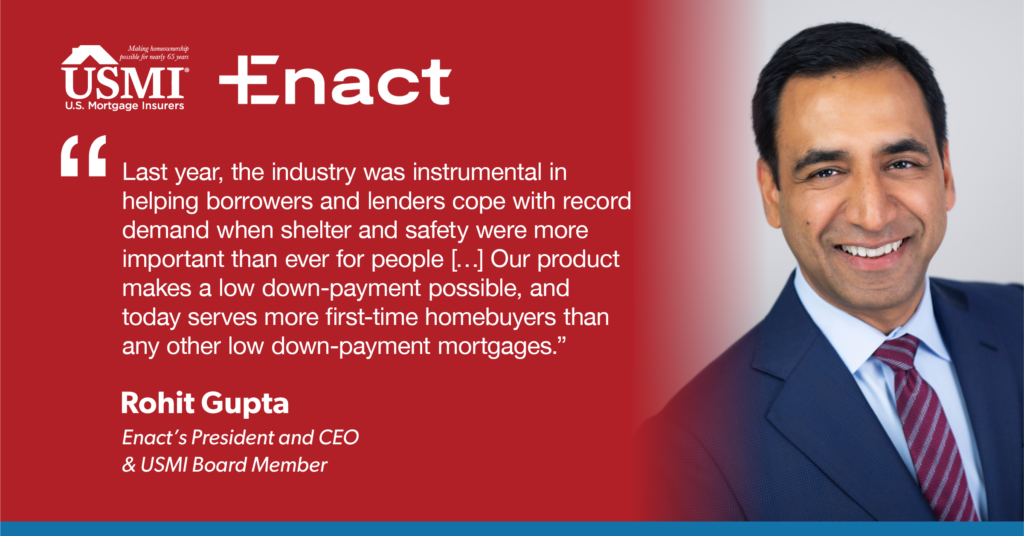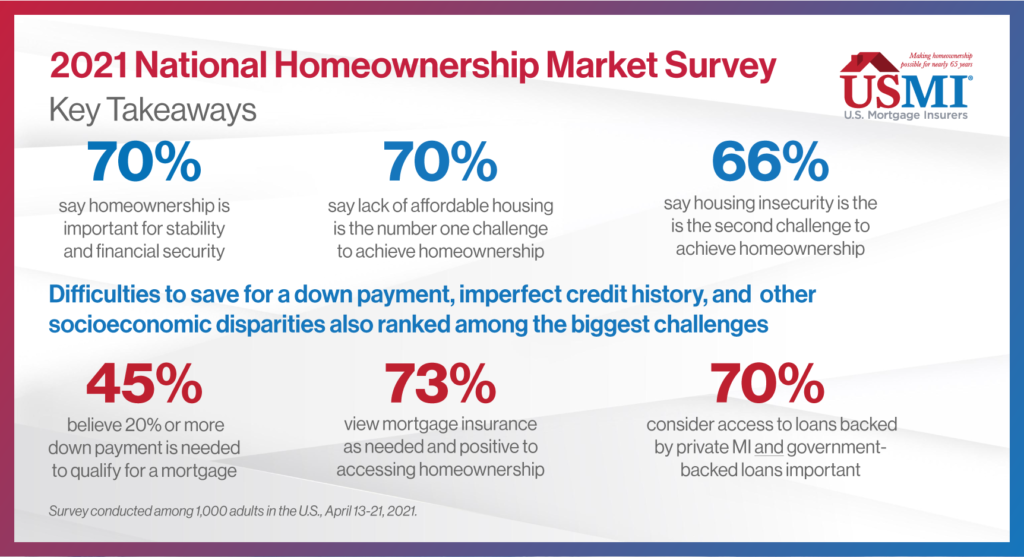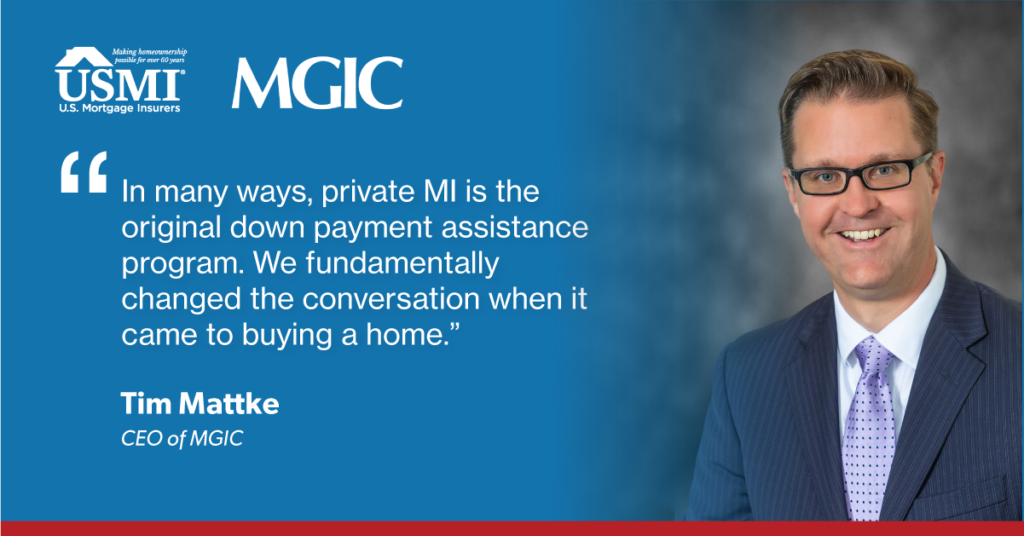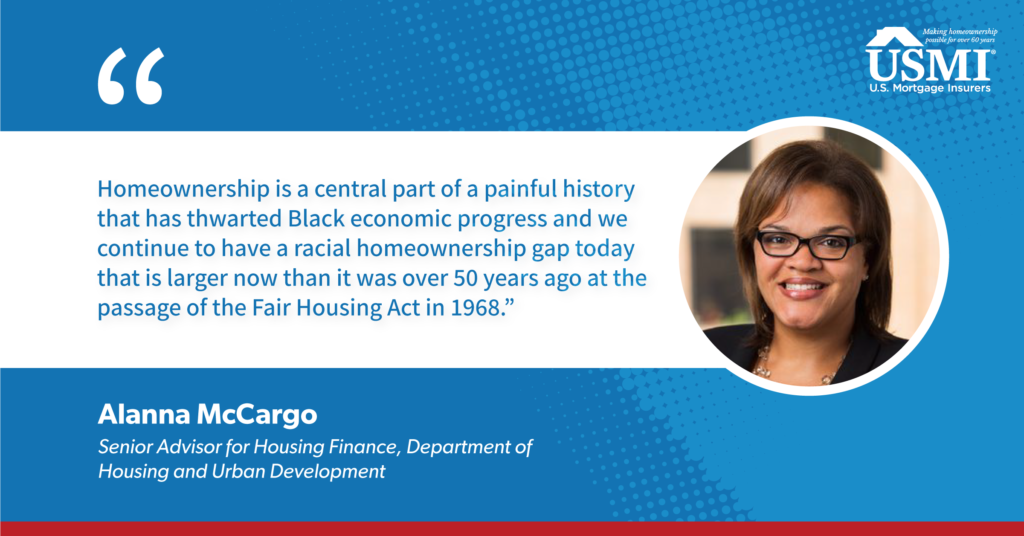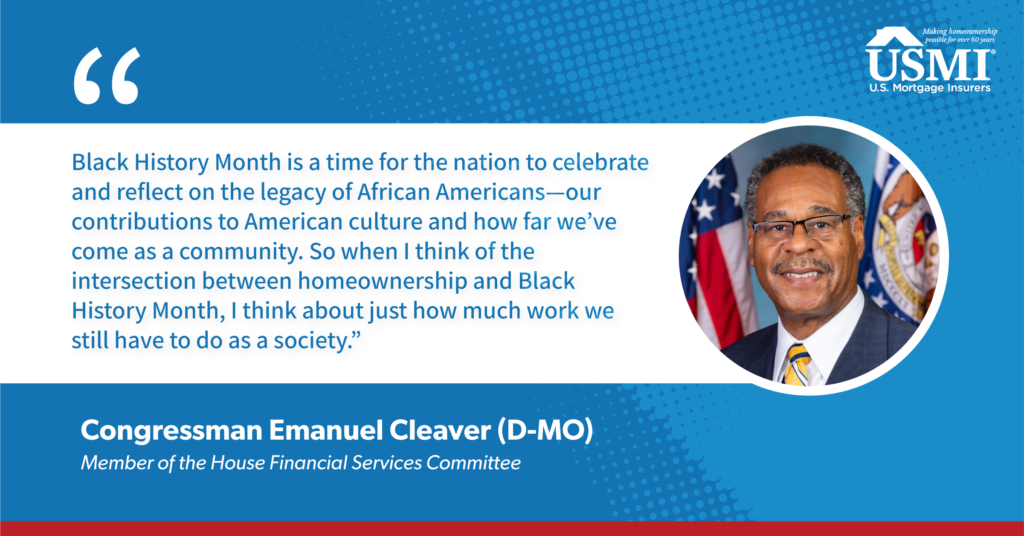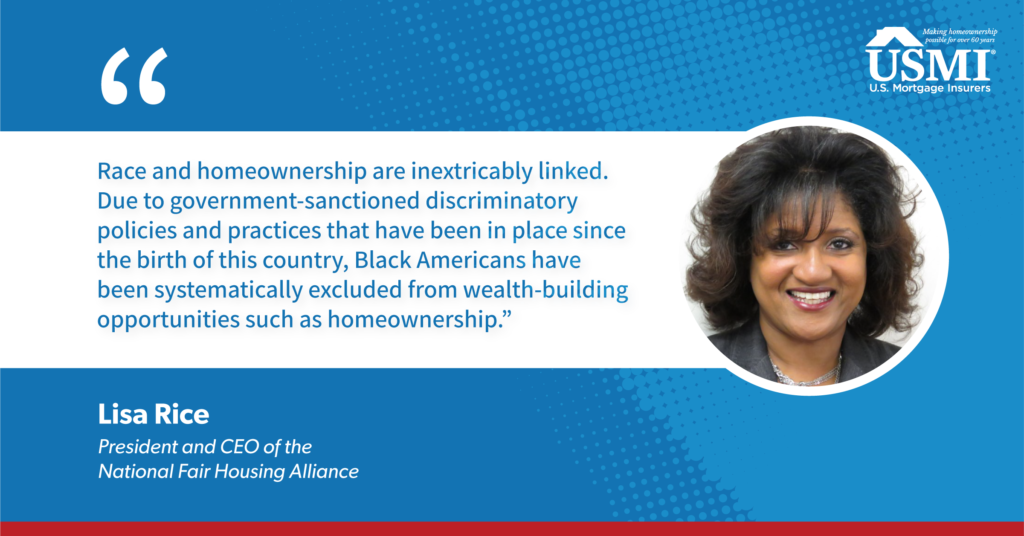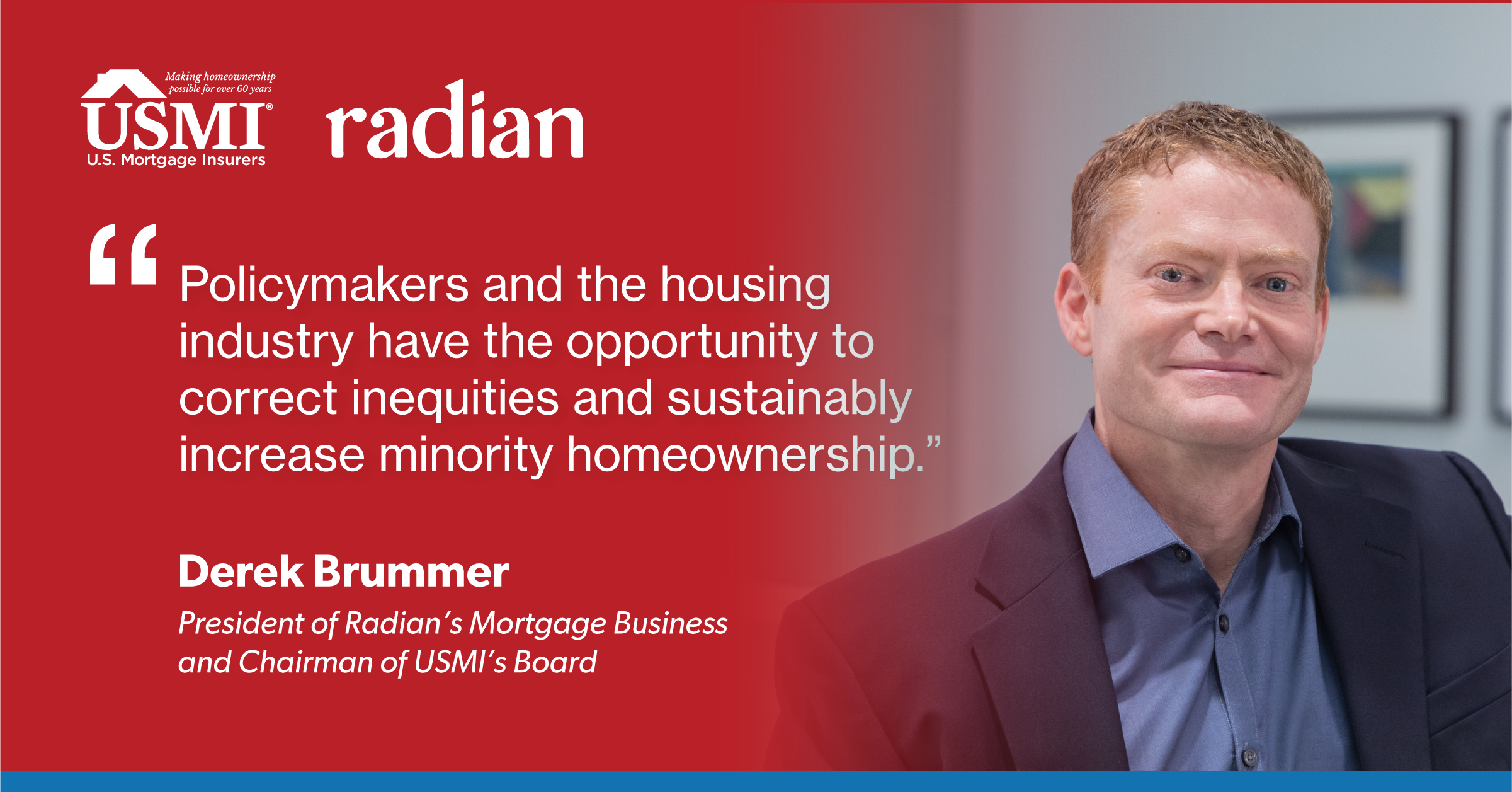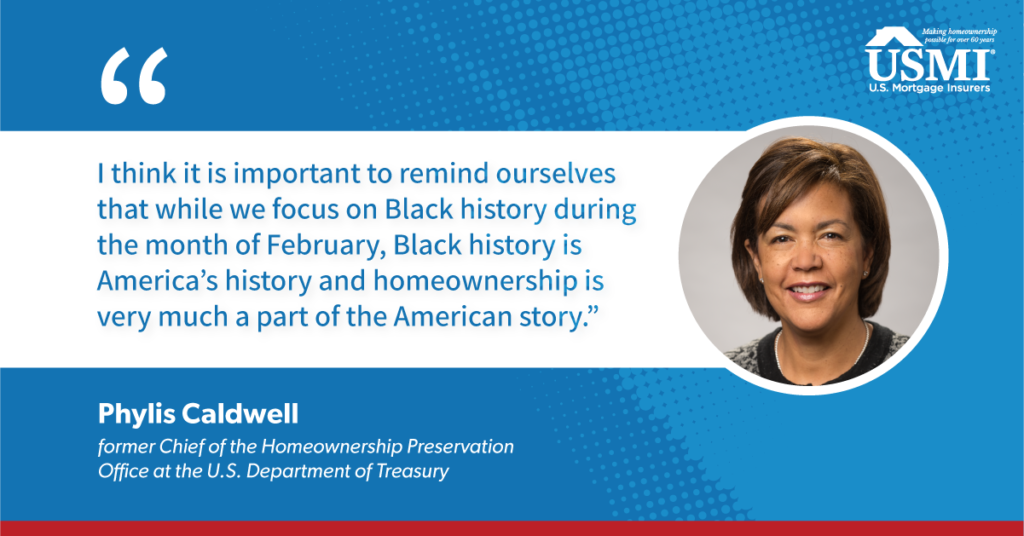The private mortgage insurance (MI) industry helped over 2 million low down payment borrowers secure mortgage financing in 2020, a 53 percent increase from the previous year. The industry also supported $600 billion in mortgage originations. USMI President Lindsey Johnson sat down with National MI CEO Claudia Merkle to discuss the record-setting year. Also, in honor of Women’s History Month in March, the two talked about ways women can seek a long, successful career in housing finance. Watch the full interview below and click here to read more about the record high private MI volume. (Please note the interview was recorded before the final volume numbers were finalized, so there are slight variations between the video and press release. The press release has the most up-to-date numbers for 2020.)
Below is a complete transcript of the above video.
Lindsey Johnson: We are here to talk about the private mortgage insurance industry and the industry’s performance through 2020, a year that was full of new challenges and opportunities. 2020 was a record year for the mortgage industry, and a year where the private mortgage insurers helped a new record number of borrowers achieve homeownership. To help talk us through the numbers, Claudia Merkle, CEO of National MI, is with us. Claudia has extensive experience in the mortgage insurance and mortgage banking industries. As CEO of National MI, Claudia is responsible for the company’s day-to-day management, financial performance, and long-term growth strategy.
As we celebrate Women’s History Month, USMI wanted to highlight Claudia’s impressive experience and important contributions to the housing and mortgage industries, and we look forward to hearing some of Claudia’s thoughts on some of the most pressing issues facing the industry today. So, Claudia, thank you for being here. I did want to just start off by talking about 2020, and despite the uncertainty and the incredible challenges that were presented by the 2020 global pandemic, the real estate market was very strong this past year and the data shows record high volume. Can you peel back some of these numbers and just share your thoughts on 2020’s market, particularly for low down payment borrowers?
Claudia Merkle: Sure, Lindsey. Great to be here. So, 2020 certainly was a year of remarkable challenge, resiliency, and reward for the housing market. Based on industry and federal agency data that has been released today, 2020 mortgage lending activity broke records. First lien originations totaled just over $4 trillion in 2020. The private mortgage insurance industry also produced record volume in 2020. As background, private mortgage insurance companies, such as National MI, enable borrowers to gain access to the housing market more quickly by allowing down payments with as little as 3 percent. The private MI industry directly serves and supports low down payment borrowers in the housing market while protecting lenders against default. The MI industry helped at least 1.75 million families either purchase a home or refinance an existing mortgage.
I mentioned the strength of the broad origination of market in 2020, but we have seen even stronger growth in the private MI market. In 2020, private MIs supported $600 billion in originations, and that traces to several factors. First, there are more and more first-time homebuyers coming into the market. They have good credit, but struggle to put 20 percent down on their first house. Private MI is a great fit for them. Here’s some additional important statistics. Nearly 60 percent of purchase loans with MI are first-time homebuyers, and more than 40 percent of borrowers with MI mortgages have annual incomes below $75,000. This fundamentally underscores the point that MI serves a key demographic of borrowers needing a low down payment mortgage.
A second factor attributed to this large MI market is low interest rates. Rates helped fuel the strong mortgage market momentum in 2020 for both the purchase segment and also for refinances. We have seen private MI penetration of refinancing more than double, with a 65/35 split between purchase and refinance transactions. The combination of these various factors contributed to a really strong production in 2020.
Johnson: It’s such a great overview of some of the borrowers that we helped through 2020 and the critical role that the industry really played in helping millions of people access affordable mortgage credit when rates were really at historic lows. Can you speak to how the industry managed the COVID crisis while also meeting that incredible demand?
Merkle: Sure. Yeah, importantly over the past year the MI industry has worked closely with federal policymakers, industry groups, and consumer organizations to support homeowners experiencing financial hardship due to the COVID-19 pandemic. Mortgage insurers have routinely updated their guides and processes to align with the GSE policies in order to implement nationwide forbearance programs. One key element of the industry’s success and ability to scale up for record volume is the industry’s transformation since the 2008 financial crisis into sophisticated managers of mortgage credit risk.
Additionally, it’s important to note that the MI industry as a whole entered into the COVID crisis with a tremendous amount of financial strength. Today, mortgage insurers are well capitalized, and USMI members currently hold more than $6.3 billion in excess of PMIERs requirements, a sufficiency ratio of 149 percent. All USMI members were able to raise capital in the debt and equity markets throughout 2020 in order to scale up and support the increased volume. It’s terrific to see that the capital markets have shown confidence in our MI industry, which furthers our ability to pursue new business and support lenders and borrowers in the current market.
Johnson: So, it’s really great to hear how the strength of the industry and that transformation supported that ability for the industry to really enable access for millions of borrowers and support that volume. So, we’ve talked a lot about the volume for 2020. What are your expectations for the housing market, and in particular, the low payment market for 2021?
Merkle: Yeah, the housing market continues to be a really bright spot during the challenge of the pandemic. So, we expect home price appreciation will continue as demand continues to outstrip the supply. Forecasts indicate the 2021 originations will be approximately 3.5 trillion, which is less than the record breaking 2020 volume, but still very high based on historical trends.
As we begin to see mortgage interest rates start to rise modestly. Fewer homeowners will be in the money to refinance. The purchase-refi breakdown could likely trend back to normal shares of the market. That split is traditionally around an 85 percent purchase and a 15 percent refinance mix. But the 2020 refi boom shifted that mix of new business to 65/35.
We’re also closely monitoring extensions of the GSE’s single-family forbearance programs and trends concerning loan modification for homeowners with COVID-19 financial hardships. We believe that the government’s support is crucial to assist impacted homeowners by providing an adequate runway to recover from financial hardships triggered by COVID. Broadly speaking, the housing industry has been a strong economic driver in the wake of the pandemic and a way to expand access to all the benefits that homeownership provides, which include a safe environment to shelter from the virus, an ability to establish community identity, and an equitable opportunity for long-term wealth creation.
It’s important to note that COVID has brought into sharp focus the important role that the private MI sector and industry plays in supporting a healthy and functioning housing finance system. We foresee that MI will continue to work for borrowers, lenders, and taxpayers in 2021 and beyond, across all markets cycles.
Johnson: So, you highlighted the importance of having a place to call home, especially during this pandemic. Considering your extensive experience in the mortgage industry and the key roles you’ve played, both on the lending side and on the mortgage insurance side as well as an executive of National MI, what is your message to Washington lawmakers and regulators about how the private mortgage insurance industry can better serve low- to moderate-income borrowers?
Merkle: Yeah, very important question. Thanks, Lindsey. So first and foremost, members of USMI commend the swift actions that Washington lawmakers have made to support borrowers during times of hardship through COVID. The first and most impactful priority has been providing continuing support to the housing market, and we were pleased to see the extension of forbearance that was announced in February.
The MI sector understands how crucial it is to participate in policy discussions that define and shape the mortgage industry, and to ensure we are adequately serving the needs of low- to moderate-income borrowers. When thinking about affordability and serving low- to moderate-income families, it is important to consider two things: one, access to credit, and two, supply. With access to credit, the MI industry has the capacity and the desire to help even more low- and moderate-income families become homeowners and to do it in a sustainable way that sets borrowers up for success.
Policymakers need to be mindful, however, of the impact federal regulations can have on the mortgage market with tilting the scales in favor of particular lending programs. Policymakers should ensure a level playing field to avoid a bifurcated market, such that minority borrowers are arbitrarily directed to lending programs with fewer lender and product options. These borrowers shouldn’t be left with the only option of a loan insured by the Federal Housing Administration (FHA), especially since there are nearly three times the number of HMDA (Home Mortgage Disclosure Act) reporting lenders originating conventional purchase loans compared to FHA purchase loans.
As it relates to supply, access to credit is a critical part of our industry, but policymakers must also consider the severe lack of affordable housing supply. Housing supply is at the lowest level this century, with just 1.9 months of supply as of January 2021. The shortage is especially acute in the lower end of the market, where many first-time buyers are looking for starter homes. The lack of supply in turn has led to record year-over-year home price appreciation, which was 10.8 percent last year according to the Federal Housing Finance Agency (FHFA). Strong home price appreciation is great for current homeowners but creates a moving target for those looking to transition from renting to owning.
Johnson: So, you touched on supply and access. From an access to mortgage credit perspective, we know that private mortgage insurance facilitates low down payment home financing in the conventional market because executives like you and others are in the market every single day, in the trenches, really making that possible. Can you elaborate on the importance of low down payment lending?
Merkle: Sure. Yeah, with mortgage insurance we’re in the dream of homeownership business. I’m really proud of that. Low down payment mortgages are critical to enable first-time, lower wealth, and minority homebuyers achieve this dream of purchasing a home. For many borrowers, the need to accumulate a large amount of cash for down payment, usually 20 percent of the property’s value, is the biggest hurdle in the homebuying process. Eighty percent of first-time homebuyers utilizing financing do so with low down payment mortgages. Conventional mortgages with private MI have been the number one way in recent years for these borrowers to become homeowners.
Between rising rent, student loan payments and strong home price appreciation, it could take a family on average of more than 20 years to save for a 20 percent down payment to purchase a home. There are many creditworthy borrowers who do not have 20 percent who deserve to have options to enable them to get into homes and to enjoy the benefits of homeownership. With MI, it is important that these families have access to mortgages with 3 percent, 5 percent or 10 percent down payments, so they can purchase homes sooner and begin to build the long-term wealth and pride that comes with homeownership.
Johnson: So as with most things, there’s always a balancing act. And the conversation, especially in DC, is constantly kind of around this access to mortgage finance credit, but sustainability and making sure that you’re not exposing taxpayers to undue mortgage credit risk. So, can access to low down payment programs be expanded without increasing that risk to government or taxpayers, and if so, then how do we do that most effectively?
Merkle: Sure. So private capital plays an essential role in a strong functioning housing market. For nearly 65 years, the private MI industry has played a critical role in facilitating access to affordable low down payment mortgages, while also protecting the GSEs, lenders, and American taxpayers from mortgage credit risk. MIs have stood in the first loss position, all while helping more than 34 million families secure low down payment mortgages and financing.
As an industry that is fully committed to the U.S. housing finance system, and one that has never stopped writing new business, insuring loans or paying claims, private mortgage insurers are an important source of private capital. We are stronger and more resilient than ever, with well-capitalized balance sheets and the capacity to serve all borrowers that don’t have 20 percent down needed to purchase a home.
A key development over the past several years has been the industry’s programmatic use of credit risk transfer, CRT transactions, in order to access the global capital and reinsurance markets to disperse risk. Since 2015, the industry has issued 35 insurance link notes deals, ILNs, transferring $14.3 billion of risk on nearly $1.4 trillion of insurance in force. USMI members have also executed 29 reinsurance deals since 2015, transferring nearly $34 billion of risk on approximately 700 billion of insurance in force.
Johnson: So kind of continuing on the theme of that balance, there has been this long standing debate about the appropriate balance between government- and taxpayer-backed FHA, and then utilizing MI. In one, the government backs a 100 percent of the risk, and in the other, the industry and private capital is standing in the first loss position, as you mentioned. How should policymakers be thinking about these two markets and the important role that they each play? And as some call for an expansion of FHA, why is it important for lawmakers and regulators to take equivalent steps to ensure access to the conventional market?
Merkle: Yeah, an important topic. So conventional loans with MI and mortgages insured by the FHA are the two primary methods for American families to attain homeownership with down payments of less than 20 percent. Policymakers should consider that both private MI and FHA have a critical place in a functioning housing finance system, critical that there be a coordinated federal housing policy to ensure that the FHA and conventional mortgage markets complement one another rather than purely compete against each other.
There is an appropriate balance between the two entities and the role that they each serve. We need to stress the importance of private capital in the housing industry and the need to lessen the current burden placed on FHA, which is directly connected to taxpayers. Plus for some borrowers, conventional execution with private MI is much more attractive than an FHA loan.
It’s also important that policymakers calibrate housing finance regulations, including the qualified mortgage standards and GSE capital requirements, to make sure borrowers aren’t arbitrarily driven to a specific program. FHFA should revisit loan level price adjustments (LLPAs), and either eliminate across the board, or at a minimum, exempt mortgages with MI since low down payment borrowers, many of them who are minority, lower-income and/or first-time homebuyers, are double charged for risk protection.
Additionally, home ready borrowers should have access to a wide variety of mortgage lenders and products across the conventional and FHA markets. I’d also comment that FHA should focus on its core mission of supporting borrowers who do not have access to traditional financing and have policies in place to ensure it can play its designed countercyclical role. The conventional market, including the private mortgage insurance industry, is backed by private capital and is well positioned to play a larger role in facilitating access to affordable credit. So, we should strive to secure the appropriate balance between the private and public sectors.
Johnson: Claudia, this has been fantastic. I would be completely remiss if I did not acknowledge that it is Women’s History Month, and as the mortgage industry generally has been historically led by men, I think it’s important to appreciate perspective, experience, and the expertise that women can bring to the table. What’s your message for young ladies in the industry who seek a long and successful career?
Merkle: Yeah, and congratulations to you as well for Women’s History Month, Lindsey. Yeah. One of my passions is finding ways to help other women in the mortgage insurance, mortgage industry in general succeed. And that includes mentoring and giving advice and certainly leading by example. Women bring a diverse skill set to the table, and while there are many messages to share with young women in our industry, I’d offer out two important messages. One, I’d say, take the initiative. Take the risk. Raise your hand for that project and lead it. Don’t wait. Don’t be too polite. Two, I’d say maintain a high organizational awareness. Who are the leaders you need to connect with? What’s happening throughout your company, and how do you lock arms with those leaders to move the organization forward?
And I’ll leave you with one final thought, Lindsey. As women, we have the unique ability to know how things are shifting, whether it’s good or bad. We were born empathetic leaders. If you have a sense that something is shifting in your organization, think about what you need to do to either change the course or further the course; then set the pace by taking action.
Johnson: That is fantastic advice. And I just want to thank you again, Claudia, for the updates on the private mortgage insurance industry and how it’s really aided the efforts and supported the efforts of the GSEs, of lenders and policymakers, through COVID-19. But also how the industry has facilitated homeownership for a record number of borrowers this year, and it continues to do so while shielding the government and taxpayers from risk. We are super grateful for your leadership and also just your insights as we had this conversation today. Thank you.
Merkle: Thank you so much, Lindsey. It was great to be here. Really appreciate it.




